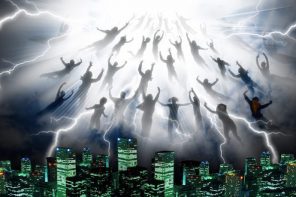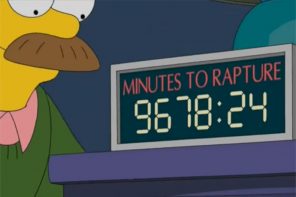In all of the hullabaloo created by the apocalyptic calculations and curious contradictions we’ve all witnessed in the past few weeks, a couple of the more curious fundamentals of such Christian apocalypticism have gone relatively unnoticed.
Here’s what we should be sure to notice: The would-be prophet of the end times is actually a world-weary denizen of the here and now. Such a prophet is also radically, and sometimes rabidly, anti-democratic. And for all of these reasons, such prophets stand much closer to heresy than they realize.
Running contrary to the utterly predictable run of “I told you so,” finger-wagging that any failed prediction of the end of the world seems destined to produce, Randy Balmer reminds us that there’s a lot of history behind predictions of this kind; that such revelatory computation has been a staple of Anglo-European religiosity for more than two hundred years. Gary Laderman, meanwhile, suggests that there’s a lot more going on in such cultural (as well as religious) events than stupidity, irrationality, or mindless demonization of “the world.”
I’d like to ask whether we can climb inside the mental world of a predictor of the Apocalypse, to say more about what they see and about what that might mean. Can we learn more about what they believe the main signposts on End-Times Road looks like? And can we discern any larger lessons about what such a belief system wittingly or unwittingly implies?
There are several related assumptions that help to make sense of these prophetic attempts to discern the signs of the end times in the here and now.
First, it’s instructive to note that the New Testament book of Revelation is consistently read in tandem with the Hebrew book of Daniel, the same book from which early followers of Jesus are said to have borrowed his title, “the Son of Man.”
Second, though probably first in importance, these books are read, not as psychedelically evocative or literary texts, but as straightforwardly historical ones. Each event, or person, or pattern described is believed to correspond to a real thing in real time.
The problem, of course, is that a contemporary reader of these texts cannot possibly know in any simple way what “Gog,” or “Magog,” or the “Whore of Babylon,” are intended to mean. Sure, they may refer to Iraq and Iran, but they may just as easily refer to Pascagoula and New Orleans. Natural and human disasters abound, always.
So there is a necessary, if mostly unstated, art of reading that lies at the heart of these artful and apocalyptic musings upon certain select scriptures. How then to read them well?
These texts are believed to be encrypted texts, as it were; texts that offer up subtle clues about the history of the world, from Christ’s Crucifixion right up to his Second Coming. The Holy Spirit is believed to have embedded these clues within the scriptures, perhaps with a depth and subtlety not consciously grasped by their human authors (Daniel and John), who were more like divine placeholders than authors in the modern sense.
That is why certain later people are identified by this same Spirit to be the elected readers for their generation, offered a way to crack the hidden codes of divine scripture. In most cases, the very belief that a given reader of the Apocalypse had been divinely appointed carried with it the clear implication that those times must be very close. Otherwise, we wouldn’t need such a close and spiritually esoteric reading at all.
If that is, roughly speaking, how such apocalyptic calculations have looked and behaved in the past two centuries or so, then several things stand out about the structure of the thing.
The notion that certain scriptural texts are esoteric texts with hidden meanings puts them very much at odds with what are otherwise believed to be clear and straightforward scriptural revelations. These two scriptural texts—one written by John the evangelist, the other by the prophet Daniel—are not at all clear. We need help to see their deeper meaning: a meaning planted beneath their polished surface by Spirit.
In other words, these apocalyptic texts speak to the Gnostic underside with which orthodox Christianity has always flirted since the first and second centuries. Today’s biblically-minded and apocalyptic predictors may have more in common with the authors of the Gospel of Judas or the Gospel of Mary than they think. They are certainly far closer to the very first heresies Christianity produced than they are to orthodoxy.
The reason for that takes us to the second most striking thing about nineteenth and twentieth century apocalyptic thought (and yes, now twenty-first century thought… it just keeps on going). The main idea is that there’s something deeply wrong with the world. It is not our home and we are not at home in it. We are merely sojourners here, biding our time until we step off into that great journey that will take us to a better place. The Christian is an alien in the here and now, precisely to the degree that he or she anticipates the end atimes with eager anticipation.
This world, the world of the here and now and the everyday, is a world given over—not necessarily to the Antichrist—but certainly to sin and corruption and matter. The apocalyptically-minded may breezily leave that world to the corporate raiders, the plutocrats, the polluters, the empires, the sexually suspect, the violent and abusive, and so on.
Such wicked people may do all they can to destroy this world; the chosen few have their eyes set on another.
And now the great paradox of Christian apocalyptic comes into starker and clearer relief. In the second century, those Christians who eventually won the day and named themselves “orthodox” complained about what they took to be the spiritual elitism (and the violence, and the wealth) of the people they called “Gnostics.” They complained that the Gnostics were too world-weary, too smarty-pants, and far too elitist.
Orthodoxy, in other words, was portrayed as a beacon of radical democracy in the violent days of the later Roman Empire. The scriptures, like salvation, were open and accessible to all, even the enslaved; there were no hidden meanings. Full transparency was the thing.
That’s the dizzying switch that makes this contemporary revel in the end times so confusing. Such apocalyptically-minded souls—nationalist and Republican, and all-too-knowing virtually to a person—are also ironically the most anti-democratic forces that contemporary Christianity has produced.
That’s why this movement and others like it are important. And that’s why they should be resisted. The true fool for Christ is no dummy.
According to Mark the evangelist, when Jesus was asked point-blank about how to compute the end times, he rejected such religious calculus out of hand, telling his followers that anyone who told them with certainty that they knew when it would come was assuredly wrong. He instructed them simply to “watch and wait” (Mark 13: 32-37).
In other words, to pay closer attention. That may be the lesson in the thing for us all.



